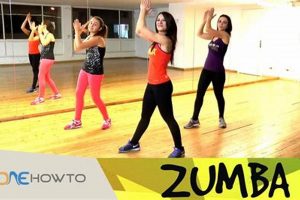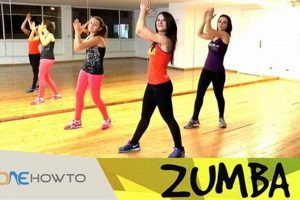A concise exercise routine, typically lasting half an hour, designed to introduce individuals with little to no prior experience to the Zumba fitness program. These sessions modify standard Zumba moves to be simpler and lower impact, focusing on building fundamental skills and familiarizing participants with basic rhythms. For example, a session may incorporate modified salsa steps, basic merengue movements, and simple cumbia routines.
The value of these introductory programs lies in their accessibility and efficiency. They offer a time-conscious approach to fitness, suitable for individuals with busy schedules. Benefits include cardiovascular improvement, increased coordination, enhanced mood, and an introduction to a social and engaging form of exercise. Zumba, as a fitness concept, originated in the late 1990s, evolving from improvised dance routines into a structured fitness program, with beginner-focused sessions playing a crucial role in expanding its reach.
The following sections will delve into the specific elements that comprise effective introductory Zumba routines, exploring considerations for music selection, choreography, and modifications to ensure a safe and rewarding experience for all participants. Furthermore, guidance on warming up, cooling down, and injury prevention will be provided.
Tips for an Effective Introductory Zumba Session
Optimizing a half-hour Zumba session for novices requires careful consideration of several factors to ensure safety, engagement, and a positive first experience.
Tip 1: Music Tempo Selection: Choose tracks with a moderate tempo, generally between 120 and 130 beats per minute (BPM). This allows participants to learn and execute the steps accurately without feeling rushed. Example: Utilize Latin rhythms with a steady, predictable beat.
Tip 2: Choreography Simplicity: Focus on fundamental Zumba steps, such as the salsa basic, merengue march, and cumbia step-touch. Avoid complex combinations or intricate footwork. Example: Break down each move into its component parts and practice it slowly before adding music.
Tip 3: Impact Modification: Offer low-impact alternatives for movements that involve jumping or high-intensity steps. Example: Replace a jump with a step-touch or a knee lift to reduce stress on the joints.
Tip 4: Clear Cueing: Provide verbal cues and visual demonstrations of each step, anticipating transitions and signaling upcoming changes. Example: Announce “Next, we’ll be doing the Merengue step for four counts” before initiating the move.
Tip 5: Warm-up and Cool-down Emphasis: Allocate sufficient time for a thorough warm-up (5 minutes) to prepare muscles and joints, and a cool-down (5 minutes) with static stretches to improve flexibility and reduce muscle soreness. Example: Include dynamic stretches like arm circles and leg swings in the warm-up, and hold static stretches for 30 seconds during the cool-down.
Tip 6: Gradual Progression: Gradually increase the intensity and complexity of the routines over time as participants become more comfortable and confident. Example: Introduce a new step or combination in each session, building upon previously learned material.
Tip 7: Monitor Participant Form: Observe participants closely to ensure proper technique and alignment, providing corrections as needed to prevent injuries. Example: Remind participants to engage their core muscles and maintain a neutral spine.
Prioritizing accessibility, clear instruction, and mindful progression maximizes the benefits and enjoyment derived from an introductory Zumba session, encouraging continued participation.
The following section will address potential challenges encountered in novice Zumba sessions and strategies for overcoming them effectively.
1. Time efficiency
The element of time efficiency is a central consideration in the design and implementation of a 30 minute Zumba workout for beginners. Given the limited duration, the program must maximize benefit while remaining accessible and enjoyable.
- Maximizing Caloric Expenditure
In a condensed timeframe, the selection of exercises must prioritize movements that engage large muscle groups and elevate the heart rate effectively. For instance, incorporating compound movements like squats with arm raises or lunges with torso twists can simultaneously work multiple muscle groups, increasing caloric burn compared to isolation exercises. The judicious use of interval training, alternating between higher-intensity bursts and short recovery periods, can further amplify energy expenditure within the allotted time.
- Structured Session Design
A 30-minute Zumba session demands a highly structured design to encompass all necessary components: warm-up, cardio segment, cool-down, and stretching. Each phase must be carefully timed to ensure adequate preparation, exercise, and recovery without encroaching on the other elements. For example, a typical structure might allocate 5 minutes for warm-up, 20 minutes for the core Zumba routine, and 5 minutes for cool-down and stretching. Deviation from this structure can compromise either the safety or effectiveness of the session.
- Simplified Choreography Prioritization
Time constraints necessitate the selection of simpler, more accessible choreography. Complex routines requiring significant learning time detract from actual workout time. For example, sticking to basic steps like the salsa basic, merengue march, and cumbia step-touch allows participants to quickly engage with the workout without struggling to learn intricate dance moves. This approach optimizes the time spent actively exercising.
- Minimizing Transitions
The time spent transitioning between songs and routines should be minimized. Lengthy explanations or setup times reduce the effective workout duration. For instance, preparing all music in advance and providing clear, concise cues for upcoming transitions can help maintain a consistent flow and maximize the time spent in active movement.
These facets underscore the inherent challenge of delivering a comprehensive Zumba experience within a 30-minute timeframe. The success of such a program hinges on the strategic integration of time-efficient exercise selection, structured session design, simplified choreography, and minimized transitions, ensuring a rewarding and sustainable fitness experience for beginners.
2. Simplified choreography
The inclusion of simplified choreography within a 30 minute Zumba workout designed for beginners is not merely a suggestion but a fundamental requirement for its success. This simplification directly impacts both the accessibility and effectiveness of the program. Complex dance routines necessitate extended learning periods, which are impractical given the limited timeframe and the beginner status of the participants. For example, an instructor attempting to teach intricate salsa patterns within a beginner’s 30-minute session would likely result in frustration, reduced engagement, and a compromised workout experience. The primary objective shifts from exercise to learning, diminishing the cardiovascular and metabolic benefits of the session.
Simplified choreography ensures that the participants can readily execute the movements, allowing them to maintain a consistent level of physical activity. This approach promotes a higher heart rate, greater caloric expenditure, and improved overall workout intensity. Consider a beginner-friendly routine consisting primarily of basic steps, such as step-touches, grapevine variations, and simple arm movements. Participants can quickly grasp these steps, enabling them to focus on the rhythm and intensity of the workout rather than struggling with complicated footwork. Consequently, the session becomes more effective in achieving its fitness goals.
The practical significance of this understanding lies in its direct application to the design of effective beginner Zumba programs. By prioritizing simplified choreography, instructors can create accessible and engaging workouts that foster adherence and promote positive fitness outcomes. The challenge lies in balancing simplicity with variety, ensuring that the routines remain engaging and motivating without overwhelming the participants. This balance is crucial for long-term participation and sustained health benefits.
3. Low impact
Within the framework of a 30 minute Zumba workout for beginners, the principle of low impact is paramount. Its incorporation mitigates potential risks associated with high-intensity movements and enhances the accessibility of the exercise routine for individuals with varying fitness levels.
- Joint Stress Reduction
Low-impact modifications decrease the force exerted on joints, particularly the knees, ankles, and hips. Replacing jumps with step-touches or high knees with controlled knee lifts exemplify this principle. This is especially crucial for beginners who may lack the muscle strength and joint stability to safely perform high-impact exercises. Failure to address joint stress can result in acute injuries or exacerbate pre-existing conditions.
- Cardiovascular Adaptability
While eliminating high-impact movements, a low-impact Zumba routine can still effectively elevate heart rate and improve cardiovascular fitness. Emphasizing larger muscle group engagement and dynamic movements maintains a sufficient level of exertion. For instance, incorporating exaggerated arm movements or wide stances during stepping patterns can compensate for the absence of jumps, ensuring cardiovascular stimulation.
- Extended Workout Duration
Low-impact adaptations enable participants to sustain activity for the duration of the 30-minute session without excessive fatigue or risk of injury. This extended duration contributes to increased caloric expenditure and improved fitness gains. Conversely, high-impact exercises might necessitate frequent breaks or modifications, reducing the overall effectiveness of the workout.
- Broadened Accessibility
A low-impact approach widens the demographic capable of participating in the Zumba workout. Individuals with joint pain, limited mobility, or those new to exercise can safely engage in the routine. This inclusivity fosters a welcoming and supportive environment, encouraging long-term adherence to the fitness program.
The facets of joint stress reduction, cardiovascular adaptability, extended workout duration, and broadened accessibility underscore the critical role of low-impact modifications in a 30 minute Zumba workout for beginners. These adaptations ensure a safe, effective, and inclusive fitness experience, promoting sustained participation and positive health outcomes.
4. Music appropriateness
The selection of music constitutes a critical determinant of success within the context of a 30 minute Zumba workout for beginners. Musical appropriateness extends beyond mere personal preference, encompassing tempo, rhythm, cultural relevance, and lyrical content. These elements collectively influence participant engagement, motivation, and adherence to the exercise regimen.
- Tempo and Rhythm Synchronization
The tempo, measured in beats per minute (BPM), must align with the intended intensity of the workout. For beginners, a tempo ranging from 120 to 130 BPM facilitates ease of movement and rhythm comprehension. A tempo that is excessively fast can lead to coordination difficulties and frustration, while a tempo that is too slow might fail to elicit the desired cardiovascular response. Rhythmic patterns should be predictable and repetitive, allowing participants to anticipate movements and synchronize their actions with the music. For instance, a consistent 4/4 time signature is generally more suitable for beginners than complex syncopated rhythms.
- Cultural Relevance and Familiarity
The selection of musical genres should reflect the cultural roots of Zumba, drawing primarily from Latin American styles such as salsa, merengue, cumbia, and reggaeton. Familiarity with these genres, or at least an exposure to their general characteristics, can enhance participant engagement and enjoyment. While incorporating music from other cultures may broaden appeal, maintaining a core focus on Latin rhythms preserves the essence of Zumba and provides a consistent framework for choreography.
- Lyrical Content and Language
Consideration should be given to the lyrical content of the music, particularly in terms of its appropriateness for a fitness environment. Explicit or offensive lyrics are generally unsuitable. Furthermore, the language of the lyrics can influence participant comprehension and engagement. While music in Spanish is common in Zumba, incorporating tracks with English lyrics or instrumental versions can enhance accessibility for diverse populations. The overall message conveyed by the lyrics should be positive and motivational, reinforcing the benefits of exercise and promoting a sense of community.
- Varied Musicality and Transitions
Although consistency in tempo and rhythm is important, introducing variations in musicality can prevent monotony and maintain participant interest throughout the 30-minute session. This can be achieved through changes in instrumentation, melodic phrasing, and dynamic range. Transitions between songs should be seamless and well-planned, minimizing disruptions and maintaining a continuous flow of movement. The use of non-stop mixes or carefully curated playlists can facilitate smooth transitions and enhance the overall workout experience.
The careful consideration of tempo, cultural relevance, lyrical content, and varied musicality constitutes a holistic approach to musical appropriateness within the context of a 30 minute Zumba workout for beginners. These factors collectively contribute to a more engaging, effective, and enjoyable fitness experience, promoting long-term adherence and positive health outcomes. Selecting appropriate music goes beyond simple enjoyment; it is a strategic tool for maximizing the benefits of the workout.
5. Instructor guidance
Effective instructor guidance serves as a cornerstone of a successful 30 minute Zumba workout for beginners. Its presence directly impacts participant safety, proper technique acquisition, and overall motivation. The compressed timeframe necessitates efficient communication and focused instruction. For instance, a skilled instructor will provide clear, concise cues for each movement, minimizing confusion and maximizing active participation time. This contrasts with less effective instruction, which may involve overly complex explanations or inadequate demonstrations, thereby reducing the workout’s overall benefit and potentially increasing the risk of injury. A lack of proper form correction, a direct result of insufficient instructor guidance, can lead to compensatory movements that place undue stress on joints and muscles, negating the positive impacts of the exercise routine.
Furthermore, instructor guidance plays a crucial role in modifying exercises to suit individual needs and limitations. Beginners often possess varying levels of fitness and may require specific adaptations to avoid injury or discomfort. An experienced instructor can readily identify those who need modifications and provide alternative movements that maintain the workout’s intensity while accommodating physical limitations. For example, individuals with knee problems might be offered low-impact variations of certain steps, ensuring they can participate fully without exacerbating their condition. This level of personalized attention fosters a supportive and inclusive environment, encouraging continued participation and adherence to the fitness program. Conversely, a lack of adaptive instruction can discourage beginners, leading to attrition and negating the potential long-term health benefits of regular Zumba exercise.
In summary, instructor guidance is not merely a supplementary component but an essential element of a 30 minute Zumba workout for beginners. It directly impacts participant safety, technique acquisition, and motivation, all critical for achieving desired fitness outcomes and fostering long-term adherence. Challenges remain in training instructors to effectively deliver concise, adaptive, and engaging guidance within a compressed timeframe, highlighting the need for ongoing professional development and specialized training programs tailored to the specific needs of beginner Zumba classes. The quality of instruction directly correlates with the success and sustainability of these introductory fitness programs.
6. Safety measures
Incorporating robust safety measures into a 30 minute Zumba workout for beginners is not merely a procedural formality but a foundational necessity. The relatively brief duration of the session necessitates a focused approach to minimizing potential risks. Failure to adequately address safety concerns can result in injuries, decreased participant confidence, and reduced program adherence. A prime example involves neglecting a proper warm-up, which increases the likelihood of muscle strains or sprains. Similarly, inadequate instruction on proper form during high-repetition movements can lead to joint issues over time. Therefore, safety protocols constitute an integral component of a well-designed introductory Zumba program.
Effective safety measures encompass several key elements: comprehensive pre-participation screening, thorough warm-up and cool-down routines, clear instruction on proper form, modifications for varying fitness levels, and a safe environment. Pre-participation screening allows for the identification of individuals with pre-existing conditions that may require specific precautions. A structured warm-up prepares the muscles and joints for activity, reducing the risk of injury. Precise instruction on form ensures proper biomechanics during exercises, preventing compensatory movements that can lead to strain. Modifications allow individuals to participate safely at their own pace. A safe environment includes adequate space, appropriate flooring, and controlled temperature and humidity. Implementing these measures minimizes the potential for adverse events and maximizes participant well-being. For instance, providing visual cues and verbal reminders about maintaining a neutral spine during torso rotations can prevent lower back injuries.
In summary, safety measures are inextricably linked to the success and sustainability of a 30 minute Zumba workout for beginners. The integration of pre-screening, proper warm-up and cool-down procedures, clear instruction, adaptable modifications, and a safe environment is paramount. Ongoing evaluation and refinement of safety protocols are essential to address emerging challenges and ensure the continued well-being of participants. Prioritizing safety not only minimizes risk but also fosters a positive and supportive atmosphere that promotes long-term engagement and improved fitness outcomes. Neglecting these aspects undermines the value and potential benefits of the Zumba program.
7. Progressive intensity
Progressive intensity, within the context of a 30 minute Zumba workout for beginners, refers to the gradual and systematic increase in the demands placed upon the participant’s physiological systems. This progression encompasses manipulations of exercise volume (duration), exercise intensity (tempo, impact, range of motion), and exercise complexity (choreography). Its absence can lead to plateaus in fitness gains, increased risk of injury, and decreased participant motivation. For example, beginning each workout with a consistent, unchanging routine can result in the body adapting to the demands, thereby negating further improvements in cardiovascular fitness or muscular endurance. Conversely, introducing complex choreography or high-impact movements prematurely can lead to sprains, strains, or discouragement.
Effective implementation of progressive intensity involves a phased approach. Initial sessions focus on familiarizing participants with fundamental movements and establishing a baseline level of fitness. Subsequently, the instructor strategically increases the difficulty. This may involve subtly increasing the tempo of the music, incorporating slightly more complex dance combinations, or introducing low-impact variations of previously performed high-impact movements. It is crucial that these progressions are implemented incrementally and with careful observation of participant responses. For instance, an instructor might introduce a jump during one song and closely monitor participants’ form and fatigue levels. If participants demonstrate difficulty maintaining proper technique or exhibit signs of overexertion, the instructor will revert to a lower-impact modification. This dynamic adjustment ensures that the workout remains challenging yet accessible.
In summary, progressive intensity is a critical, yet nuanced, element of a 30 minute Zumba workout for beginners. Its successful application necessitates a balance between challenging participants to promote adaptation and ensuring their safety and engagement. Improper implementation can lead to injury, plateauing, or attrition. Therefore, instructors must possess a thorough understanding of exercise physiology and pedagogy to effectively tailor the progression of intensity to the specific needs and capabilities of their beginner participants. The goal is to foster a sustainable and enjoyable fitness journey, enabling participants to gradually improve their fitness levels without experiencing undue risk or discouragement.
Frequently Asked Questions
The subsequent section addresses common inquiries regarding introductory Zumba routines, offering clarity on benefits, safety, and logistical considerations.
Question 1: What specific fitness level is required to participate in a 30 minute Zumba workout designed for beginners?
No specific fitness level is required. Beginner programs are designed for individuals with little to no prior experience. Modifications are typically provided to accommodate varying levels of physical ability.
Question 2: Is specialized equipment necessary to engage in a 30 minute introductory Zumba session?
No specialized equipment is generally required. Comfortable athletic attire, supportive shoes, and a water bottle are typically sufficient. A mat may be desired for floor exercises during the cool-down.
Question 3: How frequently should one participate in these introductory sessions to observe tangible fitness benefits?
Consistent participation, ideally two to three times per week, typically yields noticeable improvements in cardiovascular fitness, coordination, and mood within a few weeks.
Question 4: What are the primary safety considerations when participating in a 30 minute Zumba session for beginners?
Key safety considerations include proper warm-up and cool-down routines, adherence to correct form, appropriate hydration, and awareness of personal limitations to prevent overexertion or injury.
Question 5: Can individuals with pre-existing medical conditions, such as joint pain or cardiovascular issues, participate safely?
Individuals with pre-existing medical conditions should consult with a healthcare professional prior to participation. Modifications can often be made to accommodate specific limitations, but medical clearance is advisable.
Question 6: What distinguishes a beginner-level Zumba session from more advanced classes?
Beginner sessions typically feature simplified choreography, slower tempos, lower-impact movements, and more explicit instruction compared to advanced classes. The focus is on building foundational skills and promoting accessibility.
In summary, introductory Zumba routines offer a safe and accessible pathway to fitness for individuals of all backgrounds. Adherence to safety guidelines and consistent participation are crucial for realizing tangible benefits.
The succeeding section delves into specific modifications that can be employed to personalize beginner Zumba sessions for individuals with unique needs or limitations.
Conclusion
The preceding analysis clarifies that a 30 minute Zumba workout for beginners is not simply a shortened version of a standard class. It is a carefully calibrated program requiring specific modifications and considerations. Music selection, choreography, intensity levels, and instructor guidance must be strategically tailored to ensure accessibility, safety, and effectiveness for novice participants.
A well-designed introductory Zumba session offers a potent avenue for improving cardiovascular health, coordination, and overall well-being. Recognizing and addressing the unique needs of beginners is paramount for maximizing program adherence and fostering a positive, sustainable fitness journey. Continued research and refinement of best practices remain essential for optimizing the design and delivery of such programs, ensuring their lasting impact on public health.







